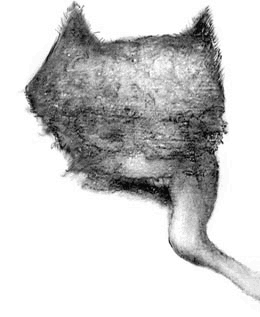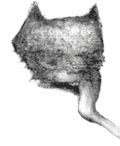|
|
|||||
| This
new image, hidden in the anterior part of the lamb, has a vaguely human
aspect, rather monstrous, and the head has two hairy ears in the shape
of horns. The front limb of the lamb is turned into a "thigh" which the monster pictured is devouring. In view of profanation inherent in the scene (the painting shows a lamb as the playmate of the Child Jesus) and the monster features, I should call this portrait "the devil". I have subsequently found, in the Treatise on Painting, Leonardo da Vinci's words, with which I have prefaced the premise in the final outline of my book. Leonardo asserts that among the things to be found in the "stains on the walls" from which one can extrapolate "inventions", there are also: "...... monstrous things, such as devil o similar things, ...". In order to see it, it is necessary to turn the painting 90 degrees counter clockwise. The main portion of the face is found in the portion of the lamb that encompasses the upper part of the right arm and left of the child. The lower part of the face, on the other hand, should be sought in the lines and shadows found in the right foot of Jesus. The right paw of the lamb is seen as if it "torn out" and "eaten" by the monster. |
|||||
|
|
|
On the left we can see the "original" image. In the interior part of the oval, we can observe "the devil". In order to see this, it is necessary "to go beyond forms". Leonardo in the central area of the image, has used a color tone slightly darken than the color of the base, in order to achieve with this the essential lines and shadow that define the face of "the devil". | |||
|
|
|
The image on the left, is the "original" brought in close focus. The second has been obtained by "cleaning" the picture "digitally", putting in evidence the lines that define the hidden image. |
|
||
|
|
|||||
| Just as with the other
hidden images, this one I discovered looking at the painting with the
naked eye, "drawn" to the right eye which is also quite
monstrous. Only later, analyzing the image on the PC, was I able to
discern the peculiarities that characterize this unpublished finding. The eye that one can make out is, as in the other case, the right eye. "Cleaning" the painting, I have been able to discover subsequently the other one, one can also see the presence of numerous hairs in the ears, and inside the mouth, the teeth are very obvious. I have, besides, noted in the head of the monster, the presence of a number of features, that joined together, form several letters, Even though they are very close to each other, almost in sequence, however, they do not seem to constitute a complete word. At least, this is the conclusion derived at studying the images in my possession. To get a more promising result, it would be necessary to study on the PC, a digitalized image of the area involved, taken directly and close up, of the original in the Louvre. |
|||||
|
|
|||||
|
|||||
|
|
|||||




